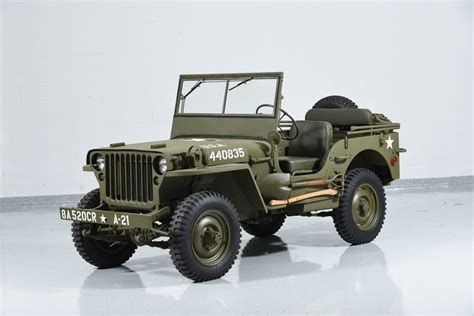March 19, 1952 – The 1,000,000th Jeep was produced. In 1939, the American Bantam Car Company submitted its original design for an all-terrain troop transport vehicle–featuring four-wheel drive, masked fender-mount headlights, and a rifle rack under the dash–to the U.S. Armed Forces. The Army loved Bantam’s design, but the development contract for the vehicle was ultimately awarded to the Willys-Overland Company for its superior production capabilities. Bantam wound up fulfilling a government contract for 3,000 vehicles during the war; but the Jeep, as designed by Willys-Overland, would become the primary troop transport of the U.S. Army. Mass production of the Willys Jeep began after the U.S. declaration of war in 1941. The name “Jeep” is reportedly derived from the Army’s request that car manufacturers develop a “General Purpose” vehicle. “Gee Pee” turned to “Jeep” somewhere along the battle lines. Another story maintains that the name came from a character in the Popeye cartoon who, like the vehicle, was capable of incredible feats. The Willys Jeep became a cultural icon in the U.S. during World War II, as images of G.I.’s in “Gee Pees,” liberating Europe, saturated newsreels in movie theaters across the country. Unlike the Hummer of recent years, the Jeep was not a symbol of technological superiority but rather of the courage of the American spirit–a symbol cartoonist Bill Mauldin captured when he drew a weeping soldier firing a bullet into his broken down Willys Jeep. By 1945, 660,000 Jeeps had rolled off the assembly lines and onto battlefields in Asia, Africa, and Europe. Many remained abroad after the war, where their parts were integrated into other vehicles or their broken bodies were mended with colorful impromptu repairs. Wherever the Jeep roamed, it lived up to its design as a vehicle for general use. During the war, Jeep hoods were used as altars for field burials. Jeeps were also used as ambulances, tractors, and scout cars. After the war, surplus Jeeps found their way into civilian life as snowplows, field plows, and mail carriers. Willys-Overland released its first civilian Jeep model, called the CJ (Civilian Jeep) in 1945.
March 19, 1952 – The 1,000,000th Jeep was produced. In 1939, the American Bantam Car Company submitted its original design for an all-terrain troop transport vehicle–featuring four-wheel drive, masked fender-mount headlights, and a rifle rack under the dash–to the U.S. Armed Forces. The Army loved Bantam’s design, but the development contract for the vehicle was ultimately awarded to the Willys-Overland Company for its superior production capabilities. Bantam wound up fulfilling a government contract for 3,000 vehicles during the war; but the Jeep, as designed by Willys-Overland, would become the primary troop transport of the U.S. Army. Mass production of the Willys Jeep began after the U.S. declaration of war in 1941. The name “Jeep” is reportedly derived from the Army’s request that car manufacturers develop a “General Purpose” vehicle. “Gee Pee” turned to “Jeep” somewhere along the battle lines. Another story maintains that the name came from a character in the Popeye cartoon who, like the vehicle, was capable of incredible feats. The Willys Jeep became a cultural icon in the U.S. during World War II, as images of G.I.’s in “Gee Pees,” liberating Europe, saturated newsreels in movie theaters across the country. Unlike the Hummer of recent years, the Jeep was not a symbol of technological superiority but rather of the courage of the American spirit–a symbol cartoonist Bill Mauldin captured when he drew a weeping soldier firing a bullet into his broken down Willys Jeep. By 1945, 660,000 Jeeps had rolled off the assembly lines and onto battlefields in Asia, Africa, and Europe. Many remained abroad after the war, where their parts were integrated into other vehicles or their broken bodies were mended with colorful impromptu repairs. Wherever the Jeep roamed, it lived up to its design as a vehicle for general use. During the war, Jeep hoods were used as altars for field burials. Jeeps were also used as ambulances, tractors, and scout cars. After the war, surplus Jeeps found their way into civilian life as snowplows, field plows, and mail carriers. Willys-Overland released its first civilian Jeep model, called the CJ (Civilian Jeep) in 1945.
0 Comentários
0 Compartilhamentos
735 Visualizações




